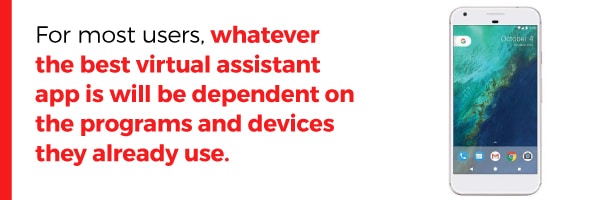
Virtual or AI assistants are the Internet of Things innovation of the decade, but it can be tricky to determine which of the various platforms offers the most enhanced capabilities at this time. Google Assistant, Siri and Alexa are the top three competitors for voice assisting, but Microsoft and Samsung are gaining traction with Cortana and Bixby, respectively, as well.
How can you decide which virtual assistant technology is right for you? Allow this guide to provide you some helpful insights into the five leading platforms.
Things to Keep in Mind When Choosing a Virtual Assistant
Because, for example, Siri is dedicated to Apple products and Alexa is primarily compatible with Amazon platforms, selecting a virtual assistant often means you are also deciding on the devices that support that specific assistant. Conversely, if you are an avid Samsung phone enthusiast, your choice of a virtual assistant may already have been made for you with Bixby well-integrated into the Samsung operating system.
A lot of the functionalities and capabilities of the most popular virtual assistants are similar across all platforms. Built within their relative operating systems, the virtual assistants all have dedicated apps or home screen access to give basic information to the user, such as calendar events, reminders, the weather and other widgets that the user can customize. You can assume that each tech company will primarily provide their best virtual assistant services within the designated ecosystem for which their virtual assistant was developed.
Across the Board: Virtual Assistant Similarities
No matter which platform you choose, you can expect your voice command virtual assistant to be able to answer simple search questions, like what the temperature is outside and when the next movie showtimes are at a theater near you. While these are capabilities all virtual assistants can ultimately perform, some may require more specific search terms or even redirect you to a web search engine to complete it.
Other basic tasks that all virtual assistants should be qualified to handle include opening an app, playing music from a default app and setting a reminder. These tasks require no third-party app accessibility apart from the apps ingrained within the operating system, such as your contacts, web browser and calendar, which your designated virtual assistant has been designed to navigate expertly.
It is in collaborating with third-party apps or performing more intensive requests that we see the most significant distinctions between AI assistant functionalities.
Google Assistant:

The Pros
In performing the simple tasks that every virtual assistant can be expected to complete, such as answering questions and setting reminders, Google Assistant struggles far less than any other virtual assistants on our list.
Here are some of the ways Google Assistant performs exceptionally well:
- Ease of use. Launching Google Assistant is quick, as saying the phrase “Okay, Google” instantly activates it to take your requests. Once Google Assistant is listening, it is easy to ask it to set the alarm, perform a web search, send a text or provide an update on the news.
- Language recognition. Google Assistant recognizes different speech patterns better than any other virtual assistant, so you can quickly make your requests without worrying about using the right words. Just speak the way you usually would as you give your personal assistant voice commands, and you shouldn’t have any trouble getting quick and accurate results.
- Tight Google integration. Google Assistant offers a uniquely extensive world of opportunity, thanks to its solid compatibility with Google services like Google Calendar, Google Maps and Gmail. Chromecast also enables Google Assistant to stream video content seamlessly through media apps.
- Answer accuracy. Because of Google’s expertise in AI and search technology, Google Assistant answers questions correctly more often than other apps and provides superior context for given information. It also cites sources for you to do further research.
- Third-party app support. Google Assistant integrates with designated third-party apps in a fairly standard way. However, when it comes to accessing Youtube videos, its speed and capabilities outrank the other virtual assistants by a long shot.
- Fun uses. Google appears to go beyond basic assistant capabilities by permitting voice commands related to playing games, taking selfies, asking for fun facts and telling jokes. It also handles follow-up questions and prompts in a way that guarantees an enjoyable experience. For example when asking virtual assistants for a recipe, Google Assistant is the only one who will offer to walk you through the steps to ensure you don’t get lost.
The Cons
Despite its excellent performance, in looking at informal user comparisons with other virtual assistants, there were a few ways in which Google briefly missed the mark:
- Useful features limited to Google Home. Specific third-party functions, such as hailing an Uber, are restricted to Google Home devices when they might be considered helpful for mobile use as well.
- Poor syncing between devices. For example, when requesting that Google Home provide directions to a restaurant, it appears that Google Assistant can’t send those directions to a phone for mobile use at this point.
Apple’s Siri:

The Pros
Siri rarely misses the mark in functioning exceptionally within the Apple ecosystem and performing the tasks for which she was designed. Here are some of the things Siri does well:
- Apple systems integration. From iTunes and Apple Mail to Contacts and Maps, Siri can handle accessing and completing given tasks in any of the core Apple device and app functions. Siri can even go so far as setting Reminders that are location-based and performing a chain of services with a single command, such as open a web browser and enter a specific web page.
- Worldwide availability. Siri is the only virtual assistant available across the world, in over thirty different countries and in twenty different languages and dialects, which sets her apart for global markets.
- Communications. Because she lives within a phone, Siri is highly adapted to make calls to contacts, compose emails by voice and read text messages back to you. In many ways, in this category, she outranks Google and Alexa. Siri can also make international calls and handle third-party communication services through apps like WhatsApp and Viber.
- Action confirmation. Before making a call or sending a text, Siri will confirm to make sure you are ready for that action to be completed.
- GPS integration. One of Siri’s strong suits is enhanced capabilities through Apple Maps. She estimates how long it will take you to get somewhere, offers directions and starts navigation automatically.
- Backward compatibility. Even older-generation Apple devices can attain current Siri capabilities as long as they can run newer iOS versions that offer Siri features. This universal availability is rare among other platforms.
The Cons
Even though Apple provides cutting-edge technology in many areas, Siri has some limitations that we need to address:
- Exclusively Apple. Siri’s tight smartphone integration is limited to iOS, and her abilities to play music is only through iTunes and Apple Music. Apple has to approve any third-party app functions, and this lack of support for non-Apple apps can be a letdown.
- Web search defaults. When asked to answer questions or give online shopping options, Siri often kicks responsibility over to a web search. While Apple employees claim that she is not meant for trivia questions, other virtual assistants boast of these capabilities, which makes Siri seem less competitive.
- Speech recognition. Siri seems to misunderstand what you say more often than other virtual assistants. She requires specific language to operate most efficiently, which can result in multiple attempts or web search defaulting.
Amazon’s Alexa:

The Pros
Through Amazon devices like the Echo, Alexa has revolutionized the market for voice-activated virtual assistant technology in the home. Alexa especially excels in the following ways:
- Third-party accessibility. Alexa outranks other virtual assistants in compatibility with third-party providers on Amazon platforms. She orders food and Uber rides, asks follow-up questions as she goes, and even handles iCloud and other competing brand systems with ease.
- Customization. Alexa can be extended to access over 15,000 third-party skills and is, overall, highly customizable to fit the specific functions you need her for.
- Conversation adaptability. Alexa gathers information continuously, allowing her to provide the most useful answers for users over the shortest amount of time, compared with other assistants.
- Online shopping. Naturally, thanks to Amazon’s broad shopping catalog, Alexa is the top virtual assistant for seamlessly placing online shopping orders.
- TV integration. Using Amazon TV devices is made much simpler with the use of Alexa. She enables opening specific streaming apps, moving in time, pausing and more without lifting a finger.
The Cons
While she functions tremendously within her platform, there are some limits to the ecosystem which may make Alexa a less suitable resource for some users:
- Device limitations. Alexa devices do work smoothly together, but there are few of these devices to choose from, and none are nearly as versatile as a smartphone. Alexa currently offers no integration with iOS or Android systems. However, a mobile app is in the works, so this may change shortly.
- Integration restrictions. In addition to poor or non-existent compatibility with other systems, some appealing features are limited to certain Amazon devices. For example, hand-held devices don’t offer Youtube compatibility with Alexa, as one user found, but Amazon home products like the Echo do allow YouTube access.
- Direction-giving capabilities. Alexa is not currently well-equipped to give adequate directions. One user found that Alexa only provided an answer relating to distance in a straight line and was incapable of determining how long it would take to get to a new location due to not knowing the user’s speed.
Microsoft’s Cortana:
The Pros
Cortana can handle most virtual assistant roles within the Microsoft ecosystems and offers support in unique systems like the Xbox. Here are some of the ways in which Cortana stands out:
- Broad availability. Cortana is the only virtual assistant that is available for download essentially everywhere. From iOS to Xbox One, Cortana works on a higher number of devices than any other AI assistant software.
- Solid Windows 10 integration. If you are a Windows 10 user, there is very little that Cortana can’t assist you in. Using email content to set reminders, giving location-based notifications and performing simple tasks within the ecosystem are among Cortana’s exemplary functions.
- Customizable learning capabilities. Through its Notebook features, Cortana allows users to customize the amount that the program learns about them and the kinds of suggestions Cortana will offer, which is appealing for security and privacy purposes.
The Cons
Here are the ways in which Cortana fell flat in comparison to other virtual assistants:
- Third-party difficulties. Whether it’s the fact that users need a separate app to handle Phillips Hue lights or that multiple attempts are required to sync with third-party systems, Cortana can use some refining in these more complex AI capabilities.
- Primarily Microsoft. Cortana functions admirably within Microsoft systems, but currently, she doesn’t have very tight integrations with Android and iOS. This reduced compatibility affects email access, video-streaming and smoothly integrating with third-party apps.
Samsung’s Bixby:
The Pros
Finally, Samsung has entered the running of virtual assistants with Bixby, which brings new attributes into the AI world:
- Screen tap emulation. Bixby has the appeal of person-like qualities that can make it feel like a physical, real-life assistant. As Bixby runs through tasks, it simulates screen taps and interacts with phone displays.
- Smooth ecosystem integration. Bixby uniquely performs mundane tasks, such as rotating pictures and deleting search history, much more effectively than others. It also works smoothly with phone contacts, streams video efficiently, and performs chained tasks without requiring separate commands.
The Cons
Bixby appears to still be a work in progress, as shown in some of the current weaknesses of Samsung’s software:
- Restricted language recognition. Bixby seems to struggle with direct commands without concrete, proper context. While it has no trouble interpreting the explicit command to perform a Google search which asks a question, asking Bixby directly to answer that same question may end inconclusively due to this language barrier.
- Limited third-party support. Currently, Bixby can only access home devices through the Samsung Hub, which costs $50 extra and may not be worth the investment to every AI user, especially with the other options available. Among other third-party difficulties, Bixby will only play music that is stored on the device itself rather than engaging in popular streaming services.
The Verdict: Who is the Best Virtual Assistant?

For most users, the best virtual assistant app for them will be dependent on the programs and devices they already use. Across the board, these assistants are well-integrated in their respective ecosystems, so if you are a devout Microsoft and Xbox user, Cortana, despite its limits, is probably going to outrank the rest as far as functionality for your specific purposes.
However, in viewing multiple side-by-side comparisons, it does appear that different AI assistants have varying strengths and weaknesses. For example, Google recognizes context and speech patterns like no one else, while Alexa can be customized to fit your specific intentions better than any other.
In the debate between the top 3, Google vs. Siri vs. Alexa, there may not be a clear winner in every category, but overall Google Assistant appears to be leading the ranks at this point due to the extensive amount of data backing it. However, Apple users can rest assured that Siri’s worldwide accessibility makes it a reasonably competitive brand on a global scale.
Currently, none of these big names are in jeopardy of going anywhere. Every AI company on this list has new technologies developing, so we can anticipate the competition to only continue to get fiercer and provide us with more capabilities and further reach in due time.
The Future of Virtual Assistants
We may start seeing new AI names on the horizon as virtual assistants become more and more commonplace in home and business settings. Among the multitude, there are a few rising competitors who stand out.
An open-source alternative to smart home devices called Mycroft promises to add an interesting competitive look at user privacy and securing information. IBM’s Watson seeks to offer unique AI capabilities to companies, and the rumored Spotify smart-hardware product ensures a change not only for the streaming company itself but could create shifts in the market.
Only time will tell who the next leaders will be in this industry, but one thing is for sure — virtual assistant technology is here to stay, so it may be time to pick a favorite, get the right gear and start getting used to integrating your virtual assistant into your daily routines.
If an upgrade is in order, make sure you brush up on the things to consider when buying or selling used smartphones. Of course, at the Whiz Cells, we’ll be happy to take your old phone off your hands and give you room to enjoy the latest AI features with new and upcoming Virtual Assistant technologies.
